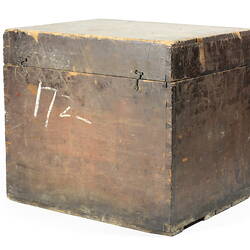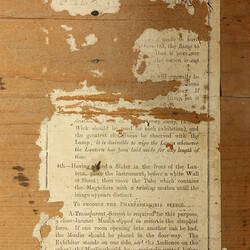Summary
Projector used to view lantern slides. Accompanied by wooden box for housing lantern. Instructions, pasted inside the box, include a description of the means by which a Phantasmagoria effect can be produced. Phantasmagoria involved using a magic lantern to project frightening images on walls, smoke and screens.
While the invention of the magic lantern is generally seen to be in the 17th century, its greatest popularity as an optical projector spans the late 18th century to the early decades of the 20th century. It was used both as a means of entertainment and education.
This lantern projector is part of the Francis Collection of pre-cinematic apparatus and ephemera, acquired by the Australian and Victorian Governments in 1975. David Francis was the curator of the National Film and Sound Archive of the British Film Institute as well as being a co-founder of the Museum of the Moving Image in London, which was operational between 1988 and 1999.
Physical Description
Lantern with rectangular wooden body, brass detailing. Brass lens tube with screw thread on inner sleeve at exposed end. Missing inner tube. Right lateral side has hinged side-swing door into illumination chamber. Closed by swivel latch. Back wall of body has A shaped aperture along bottom third opening into illumination chamber. Missing floor. Illumination chamber metal lined. Black enamelled metal roof with circular aperture for chimney. Roof does not fit onto body due to warping of metal body lining. Black enamelled metal chimney featuring typical 'elbow' joins. Wooden box with hinged top lid for housing lantern. Lid has two hasp closures. On the inside of the lid is pasted a rectangular paper instruction leaflet.
More Information
-
Collection Names
-
Collecting Areas
-
Acquisition Information
Loan & Subsequent Donation from Australian Film Institute (AFI), Mr David Francis, by Nov 1990
-
Collector
Mr David Francis, London, Middlesex, England, Great Britain, 1990
-
Inscriptions
On circular paper sticker on front of body: '23' On circular paper sticker on lid of box (outer): '374' On circular paper sticker on lid of box (outer): '394' Instruction leaflet pasted on inner side of box lid as per multimedia image.
-
Classification
Communications, Audio-visual technology, Image production equipment
-
Category
-
Discipline
-
Type of item
-
Overall Dimensions
370 mm (Length), 190 mm (Width), 325 mm (Height)
Measurement is for the body of the projector without roof and chimney.
-
Keywords
Lantern Projectors, Magic Lanterns, Phantasmagoria, Pre-Cinema Moving Images, Projectors





